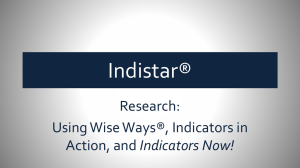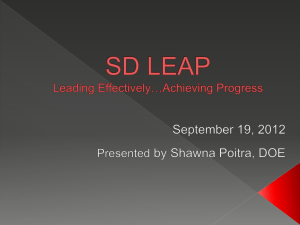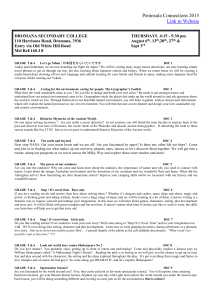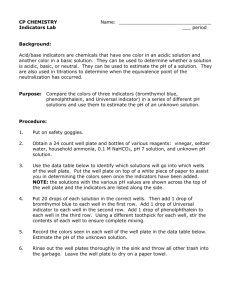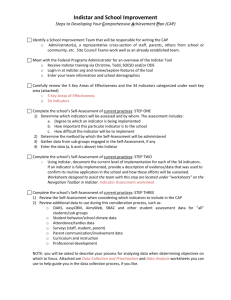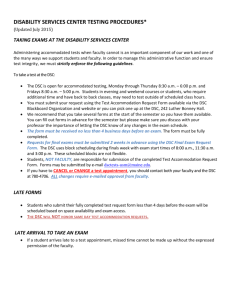OR: Support for Improvement Planning
advertisement
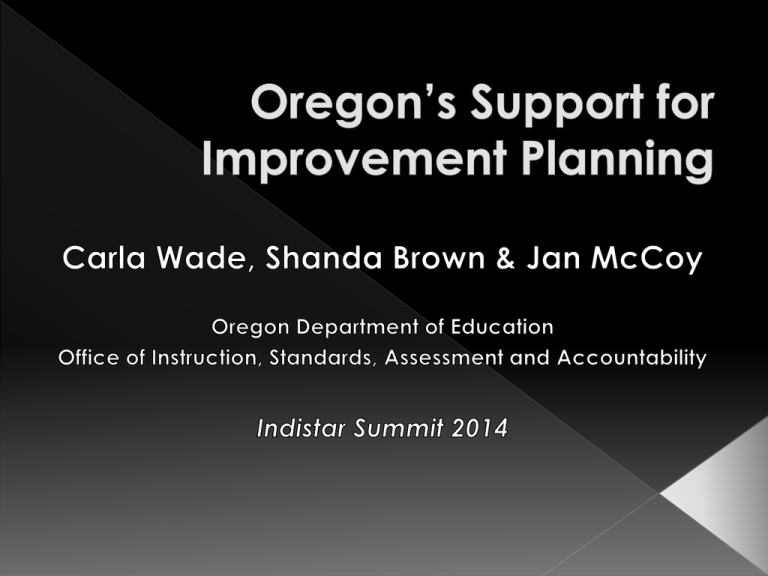
Overview and History School Improvement Research and Resources Your Feedback State law calls school and district-level Continuous Improvement Plan (ORS 329.095) › Only district plans submitted to SEA ESEA Flexibility waiver calls for a tool that supports self-assessment, planning, and monitoring for Priority and Focus Schools Provided input on alignment of Indistar indicators to state and federal planning requirements for Title IA, IIA, & III Developed new draft indicators to meet planning requirements Providing guidance on review process Committee of Practitioners Regional Network Coordinators Coaches Over 1,200 trained Indistar is our system for self-evaluation, building a plan and monitoring the plan › Indicators serve as organizing schema › Plan is the content Indicators created for Priority and Focus Schools › Indicator list narrowed from 212 to 185 then to 34 Indicators created for district planning › Experience and our Advisory Committee held us to 37 indicators Reports › Comprehensive Report › Task Report › Summary Report Uploaded documents › budgets Approval of Comprehensive Achievement Plan (CAP) › May of 2013 › May of 2014 Quarterly Feedback for CAP › November 2013 › February 2014 District: DSC 1.1 DSC 1.2 DSC 1.3 DSC 1.4 DSC 1.5 DSC 1.6 EE 2.1 EE 2.2 EE 2.3 Comment Comment Number(s) # Fully Implemented or Included in Plan (F or P) Score School: • 2012-2013 – Scored individual Indicators – Schools revise • 2013-2014 – Individual indicator quarterly feedback • 2014-2015 – Holistic Comprehensive Achievement Plan (CAP) – Rubric for school’s ability to achieve success Communication tool Feedback between school and state Opportunity to review, update and revise at any time Upload documents-all documents in one place Common tool for SEA data collection Sustainability tool after school improvement Indistar’s Wise Ways® › Valuable and initially well-received but not written to our new indicators Needed a descriptor for each indicator › Can’t call them Wise Ways®–note the little ® › Needed a name that reflected the work Oregon’s Resources and Research Attempted several iterations Decided educators had 3 questions › Why is this important to our students? › What does this look like when well done? › Where can we get more information? Brief, research-based introduction to the expected return on the indicator Brief, research-supported description of the district/school role in implementing the indicator Two types of web searches with several terms each › Google search › Google Scholar search Search terms show target best results If printed, terms are easier to type than URLs › monitoring school improvement vs. › http://scholar.google.com/scholar?q=monitorin g+school+improvement&btnG=&hl=en&as_sdt= 1%2C38&as_ylo=2004&as_vis=1 Guides educators into Google Scholar to stimulate use Google does all the work of keeping the resources up-to-date! Linked from indicator in Indistar® All included in a single PDF that is navigable Links to search terms are hot in the PDF Took advantage of PDF navigation settings 1. At your tables, please discuss one of the two R & R’s › Does the explanation of why this important ring true? › Does the “when well Implemented” hit the target? Are they missing something? › Do you think this research supports sustainable practice? › Overall impressions, comments, questions or general points of concern? 2. Whole group report out Carla Wade: carla.wade@state.or.us Jan McCoy: jan.mccoy@state.or.us Shanda Brown: shanda.brown@state.or.us
